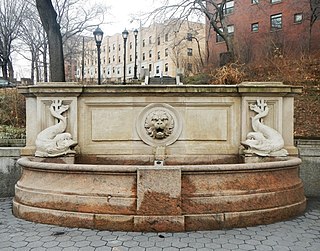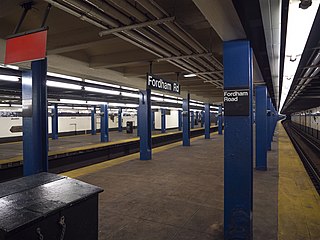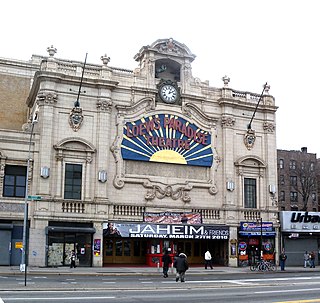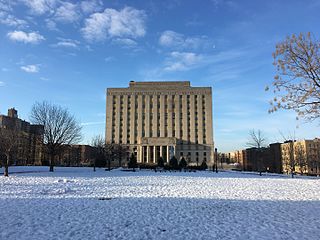
Highbridge is a residential neighborhood geographically located in the central-west section of the Bronx, New York City. Its boundaries, starting from the north and moving clockwise, are the Cross-Bronx Expressway to the north, Jerome Avenue to the east, Macombs Dam Bridge to the south, and the Harlem River to the west. Ogden Avenue is the primary thoroughfare through Highbridge.
Martin L. Puryear is an Afro-American artist known for his devotion to traditional craft. Working in a variety of media, but primarily wood, his reductive technique and meditative approach challenge the physical and poetic boundaries of his materials. The artist's Liberty/Libertà exhibition represented the United States at the 2019 Venice Biennale.

Fordham Manor is a neighborhood located in the western Bronx, New York City. Fordham is roughly bordered by East 196th Street to the north, the Harlem River to the west, Fordham Road to the south, and Southern Boulevard to the east. The neighborhood's primary thoroughfares are Fordham Road and Grand Concourse.

Bedford Park is a residential neighborhood in the northwest Bronx, New York City, adjacent to the New York Botanical Garden. Its boundaries, starting from the north and moving clockwise, are: Mosholu Parkway to the north, Webster Avenue to the east, East 196th Street to the south, and Jerome Avenue to the west.

The Grand Concourse is a 5.2-mile-long (8.4 km) thoroughfare in the borough of the Bronx in New York City. Grand Concourse runs through several neighborhoods, including Bedford Park, Concourse, Highbridge, Fordham, Mott Haven, Norwood and Tremont. For most of its length, the Concourse is 180 feet (55 m) wide, though portions of the Concourse are narrower.

Macombs Dam Park is a park in the Concourse section of the Bronx, New York City. The park lay in the shadow of the old Yankee Stadium when it stood, between Jerome Avenue and the Major Deegan Expressway, near the Harlem River and the Macombs Dam Bridge. The park is administered and maintained by the New York City Department of Parks and Recreation. The majority of Macombs Dam Park was not open to the public from August 2006, when construction began on the new Yankee Stadium, to April 2012.

The Fordham Road station is an express station on the IND Concourse Line of the New York City Subway. Located at the intersection of Fordham Road and Grand Concourse in one of the largest shopping districts in New York City, it is served by the D train at all times and the B train weekdays only.

The Bx1 and Bx2 are two bus routes that run on the Grand Concourse in the Bronx, New York City. The routes, which are operated by the New York City Transit Authority, also follow Sedgwick Avenue and Mosholu Parkway for a short distance at their northern end. As the numbers suggest, these were the first two bus routes in the Bronx.

The Bronx Museum of the Arts (BxMA), also called the Bronx Museum of Art or simply the Bronx Museum, is an American cultural institution located in Concourse, Bronx, New York. The museum focuses on contemporary and 20th-century works created by American artists, but it has hosted exhibitions of art and design from Latin America, Africa, and Asia. Its permanent collection consists of more than 800 paintings, sculptures, photographs, and works on paper. The museum is part of the Grand Concourse Historic District.

Andrew Freedman was an American businessman who is primarily remembered as the owner of the New York Giants professional baseball team of the National League from 1895 to 1902. He also briefly owned the Baltimore Orioles of the American League in 1902; the franchise would later relocate, and became the New York Yankees. Freedman was also a director of various companies, including the Interborough Rapid Transit Company and the Wright Company. He was born and died in New York City.
Fashion 时髦 Moda МОДА, whose name comes from “fashion” in English, Chinese, Spanish and Russian, colloquially referred to as Fashion Moda, started as a cultural concept guided by the idea that art can be made by anyone, anywhere. Fashion Moda was an art space located in the South Bronx, New York founded by Stefan Eins in 1978. As a museum of science, art, invention, technology, and fantasy, it was an alternative art space that combined aspects of a community arts center and a worldwide progressive arts organization until its closing in 1993.

The Paradise Theater is a theater at 2403 Grand Concourse in the Fordham neighborhood of the Bronx in New York City, United States. Designed by John Eberson as a movie palace, it opened on September 7, 1929, as one of five Loew's Wonder Theatres in the New York City area. Although the building is no longer in use as a movie theater, its facade and interior are preserved as New York City designated landmarks.

The West Harlem Art Fund, Inc. is a public art and media organization based in the City of New York, founded in 1998. Savona Bailey-McClain is its Executive Director and Chief Curator.

The Bronx General Post Office is a historic post office building at 558 Grand Concourse in the South Bronx in New York City, United States. Designed by Thomas Harlan Ellett, the four-story structure was completed in 1937 for the United States Post Office Department and later served as a United States Postal Service (USPS) branch. The interior includes a series of 13 murals created by Ben Shahn and Bernarda Bryson for the U.S. Treasury Department's Section of Fine Arts. The building's facade and interior are New York City designated landmarks, and the structure is on the National Register of Historic Places.
No Longer Empty is a New York City-based, 501(c)(3) nonprofit arts organization dedicated to orchestrating site-specific public art exhibitions in empty storefronts. No Longer Empty was conceived as an artistic response to the worsening economic condition in 2009, and its effect on both the urban landscape and the national psyche. It has since then expanded its mission to create a more lasting effect on the community through a series of programs that consist of panel discussions, art workshops, art tours and outreach and collaborations with the local community.

Bronx Academy of Arts and Dance, also referred to as BAAD!, is a New York performing and visual art workshop space and performance venue located in The Bronx. The Academy is home to the Arthur Aviles Typical Theatre and The Bronx Dance Coalition.

Concourse is a neighborhood in the southwestern section of the New York City borough of the Bronx which includes the Bronx County Courthouse, the Bronx Museum of the Arts, and Yankee Stadium. Its boundaries, starting from the north and moving clockwise, are East 169th Street to the north, Webster Avenue to the east, East 149th Street to the south, and Jerome Avenue and Harlem River to the west. The neighborhood is divided into three subsections: West Concourse, East Concourse, and Concourse Village with the Grand Concourse being its main thoroughfare.
Harry Allan Jacobs (1872–1932) was an American architect from New York City. He designed the hotel building at 22 East 29th Street, now the James New York - NoMad, a New York City Landmark. He also designed Hotel Marseilles (1905), a New York City Landmark, and the wings added to 1125 Grand Concourse.

The South Bronx is an area of the New York City borough of the Bronx. The area comprises neighborhoods in the southern part of the Bronx, such as Concourse, Mott Haven, Melrose, and Port Morris.

The New York Latin American Art Triennial is an event that takes place every three years. It is dedicated to presenting contemporary Latin American art in New York City.

















